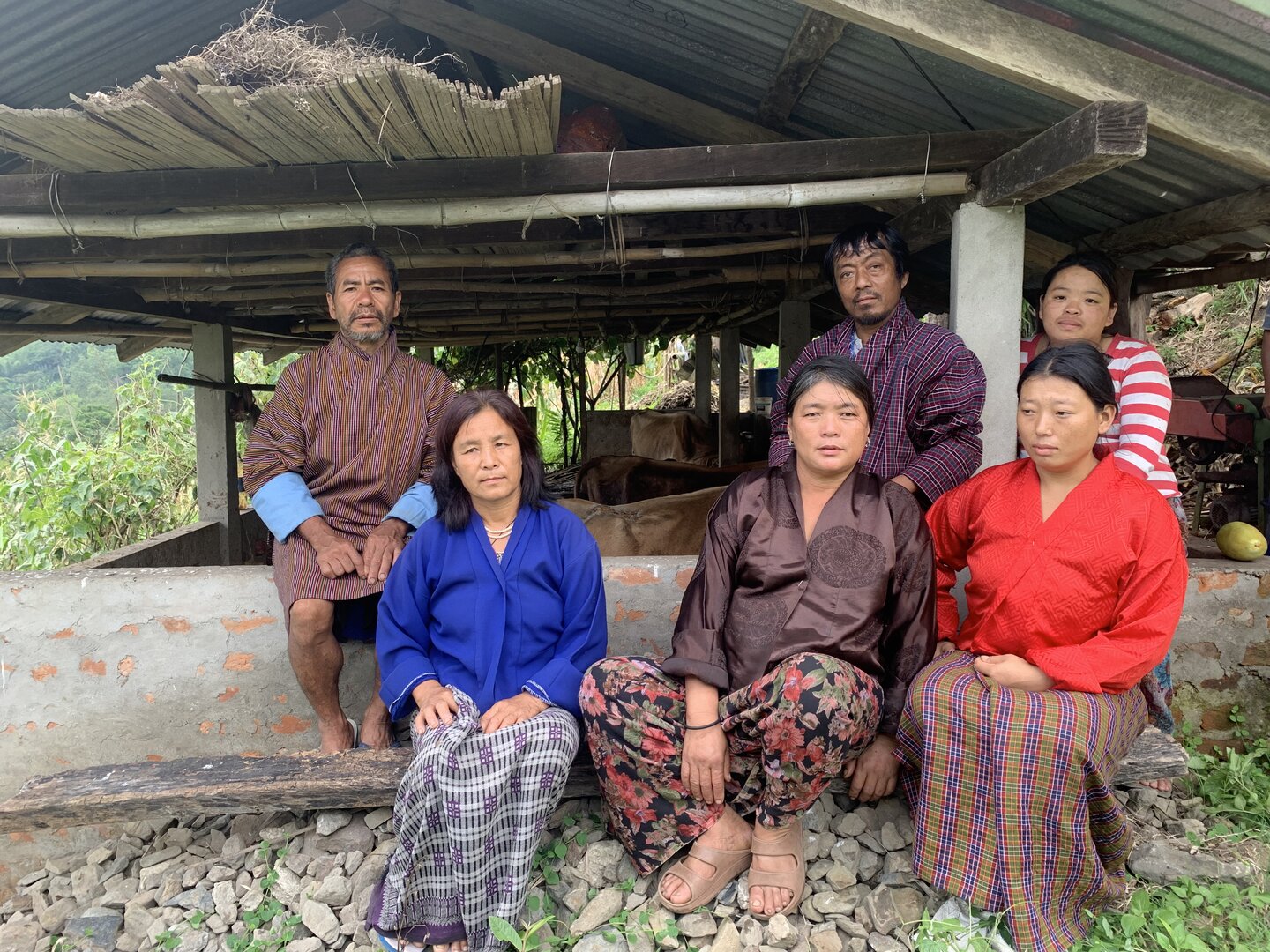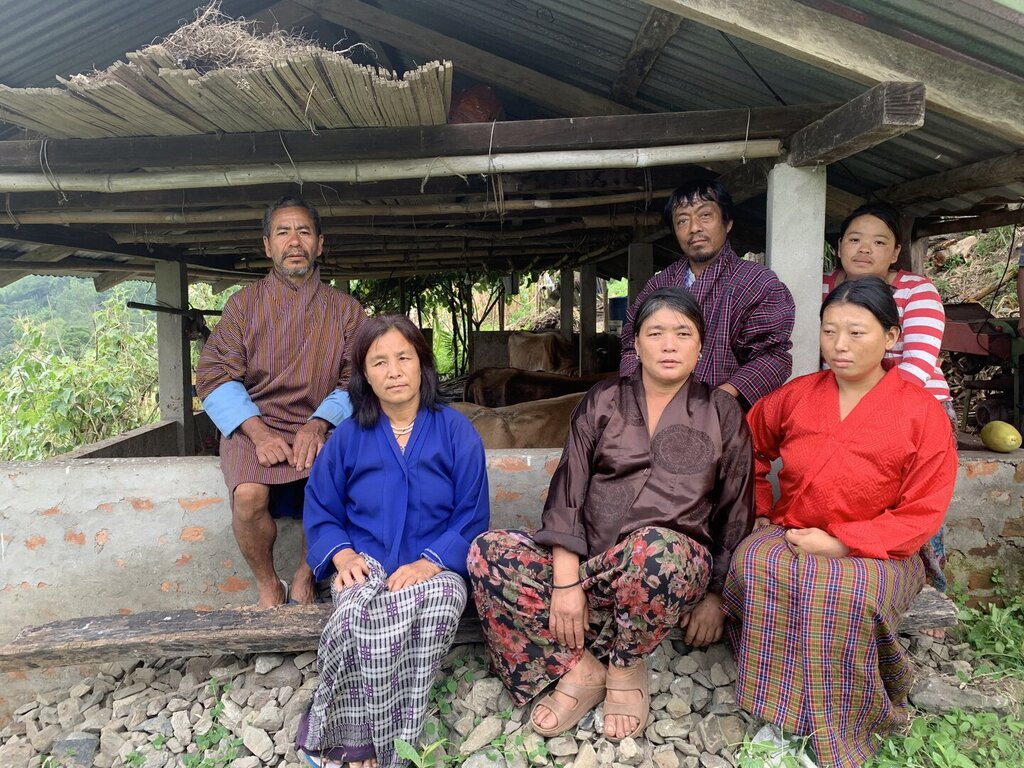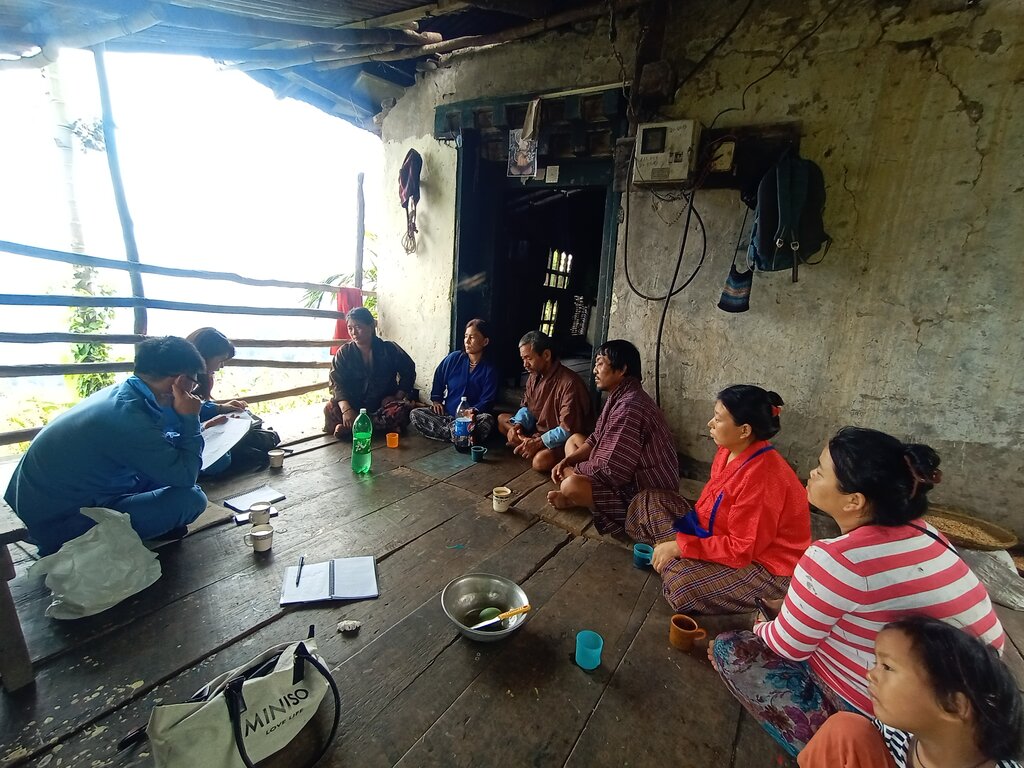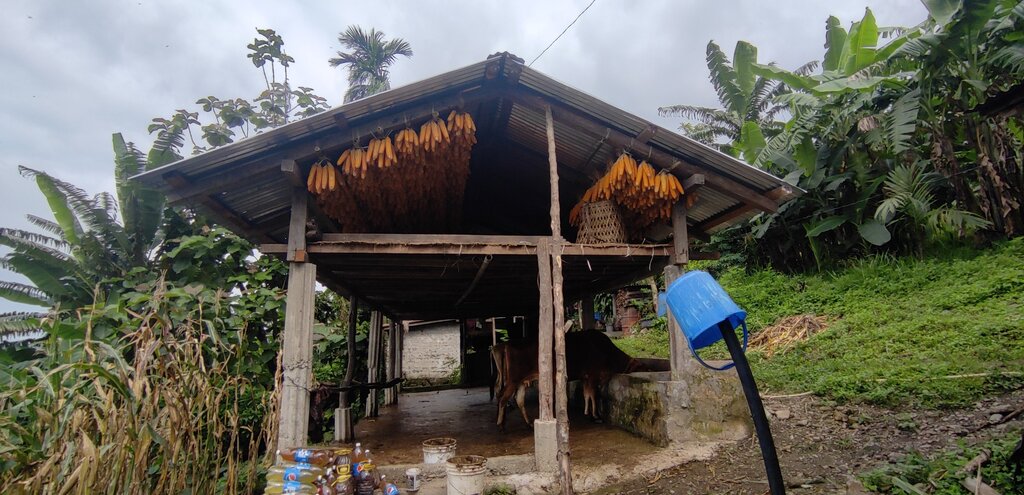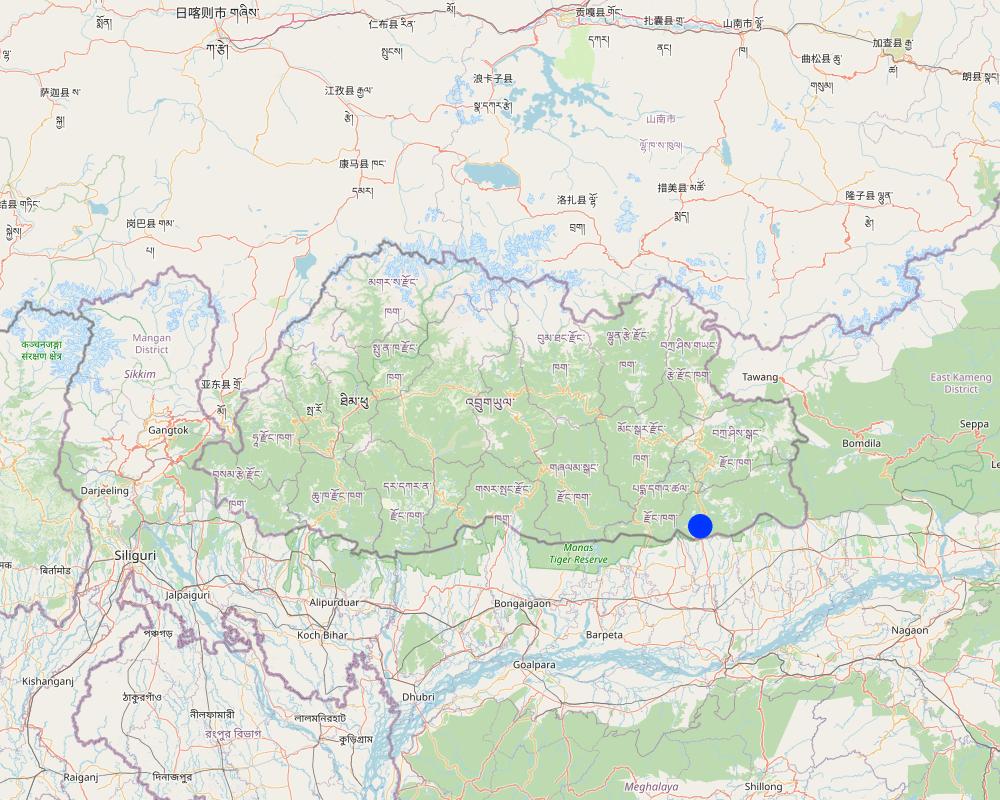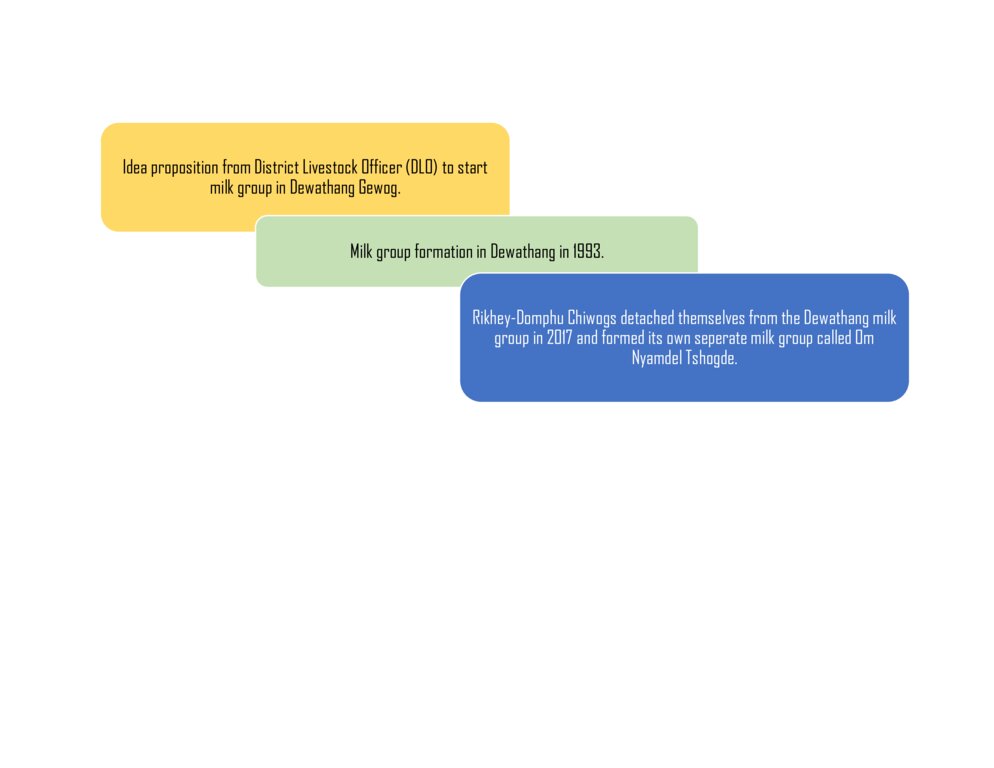Improved Livestock Farming System [Bhoutan]
- Création :
- Mise à jour :
- Compilateur : Tshering Yangzom
- Rédacteur : chenga Tshering
- Examinateurs : William Critchley, Rima Mekdaschi Studer
approaches_6895 - Bhoutan
Voir les sections
Développer tout Réduire tout1. Informations générales
1.2 Coordonnées des personnes-ressources et des institutions impliquées dans l'évaluation et la documentation de l'Approche
Personne(s) ressource(s) clé(s)
exploitant des terres:
Yangzom
17410001
Kheripam village, Domphu chiwog, Dewathang gewog, Samdrup Jongkhar Dzongkhag
Bhoutan
exploitant des terres:
Zangmo Tshewang
17967451
Kheripam village, Domphu chiwog, Dewathang gewog, Samdrup Jongkhar Dzongkhag
Bhoutan
exploitant des terres:
Wangdi
Kheripam village, Domphu chiwog, Dewathang gewog, Samdrup Jongkhar Dzongkhag
Bhoutan
exploitant des terres:
Jampel
17940948
Kheripam village, Domphu chiwog, Dewathang gewog, Samdrup Jongkhar Dzongkhag
Bhoutan
exploitant des terres:
Zangmo Tendel
17970719
Kheripam village, Domphu chiwog, Dewathang gewog, Samdrup Jongkhar Dzongkhag
Bhoutan
exploitant des terres:
Wangmo Cheki
17569913
Kheripam village, Domphu chiwog, Dewathang gewog, Samdrup Jongkhar Dzongkhag
Bhoutan
Nom du projet qui a facilité la documentation/ l'évaluation de l'Approche (si pertinent)
Strengthening national-level institutional and professional capacities of country Parties towards enhanced UNCCD monitoring and reporting – GEF 7 EA Umbrella II (GEF 7 UNCCD Enabling Activities_Umbrella II)Nom du ou des institutions qui ont facilité la documentation/ l'évaluation de l'Approche (si pertinent)
National Soil Services Center, Department of Agric (National Soil Services Center, Department of Agric) - Bhoutan1.3 Conditions relatives à l'utilisation par WOCAT des données documentées
Quand les données ont-elles été compilées (sur le terrain)?
09/07/2023
Le compilateur et la(les) personne(s) ressource(s) acceptent les conditions relatives à l'utilisation par WOCAT des données documentées:
Oui
1.4 Références au(x) questionnaire(s) sur les Technologies de GDT
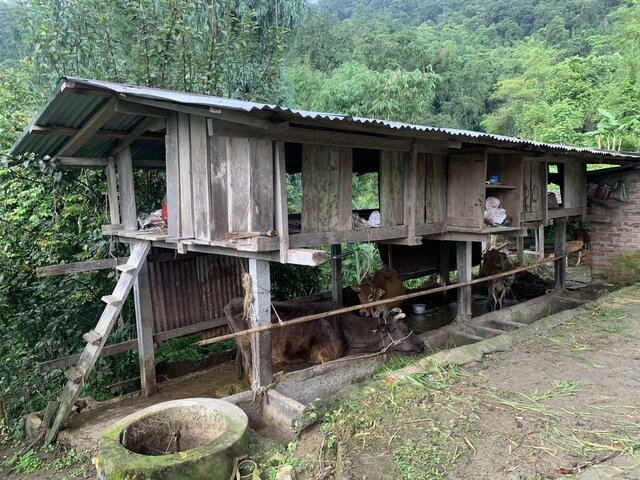
Improved Dairy Shed [Bhoutan]
An improved dairy shed in Bhutan is characterized by concrete floors, cement pillars and troughs, enough sunlight and ventilation, adequate water, ample space for cattle movement, as well as urine and dung collection gutters and a farmyard manure collection area.
- Compilateur : Tshering Yangzom
2. Description de l'Approche de GDT
2.1 Courte description de l'Approche
The approach involves a group of farmers implementing an improved dairy system. The system incorporates practices and technologies that enhance animal welfare, reduce environmental impact, and increase production.
2.2 Description détaillée de l'Approche
Description détaillée de l'Approche:
This case describes how a group approach can facilitate and encourage improved dairy production with better sheds, more productive breeds, environmental sustainability and marketing. Upgraded dairy production is described in detail under the technology “Improved dairy sheds” (T6898).
Initially, the land users were a part of a bigger milk group established in 1993. In 2017, some detached themselves and formed “Om Nyamdel Tshogde” which is a group composed of 67 members from Rikhey and Domphu chiwogs, led by a Chairperson, Mrs. Yangzom. The group also has a treasurer, Drungchen, and a driver. The main objective of forming the milk group was to improve the livelihoods of land users through higher yields via better livestock farming. The group formation process was assisted by the livestock extension officer. The funding was mobilized from the community itself.
The group members, with some support from the government, constructed improved dairy sheds, and biogas plants, and received training on fodder plantations. The stakeholders involved were land users, livestock extension officers, and the private cooperative B-COOP. The land users' role is to coordinate and conduct activities related to livestock farming. The extension officer's role is to provide veterinary and technical services. B-COOP's role is to buy dairy products from the group, especially milk.
The group members have installed improved dairy sheds with cemented floors, feeding troughs, corrugated galvanised iron (CGI) roofing, and a continuous water supply. Also, cattle have access to timely veterinary services. Cow dung and urine are used as fertilizers and also in biogas plants. Biogas plants generate renewable energy (methane), thereby cutting down the use of liquefied petroleum gas (LPG) gas which is derived from fossil fuel.
Under improved dairy sheds, stall-feeding is practised which bars the cattle from going to forests to feed. This prevents the degradation of land by cattle movement through trampling. For better nutrition and feeding, grass fodder species including Super Napier (pakchung), Napier, and Guatemala are grown, cut and and fed to cattle. In addition, other feeds provided included banana stems, maize stems, maize powder, mustard cake, and processed feeds. The group delivers at least 300 litres of milk per day to B-COOP, and some milk goes to India.
Improved breeds have replaced numerous low-yielding local cattle thereby making more efficient use of cattle feed. Also, fewer, more productive animals help reduce environmental degradation and methane losses to the atmosphere. The majority of cattle reared have been bred through artificial insemination. Most cattle are 50:50 hybrids between local breeds and improved breeds such as Jersey. Improving the breeds helps to increase milk production (e.g Holstein Friesian) and or percentage butter fat (e.g. Jersey). To feed and sustain productive, improved breeds, various fodder species are cultivated in large areas. This helps in carbon sequestration and preventing soil erosion.
What the land users like about the approach is that improved livestock farming results in a continuous source of income, as milk production is not seasonal like vegetable production, it provides organic fertilizers for fields, improves livelihoods, makes use of waste such as cow dung in biogas plants which means reduced dependency on LPG gas which is quite expensive. Also access to credit is increased. Government support has increased after the milk group formation. Furthermore, the workload is shared among the land users, especially during the making of biogas plants, thus easing the workload per person.
2.3 Photos de l'approche
2.4 Vidéos de l'Approche
Commentaire, brève description:
Cattle feeding inside an improved dairy shed
https://youtu.be/ZxV-PbV6UXY
Date:
09/07/2023
Lieu:
Kheripam village, Domphu chiwog, Dewathang gewog, Samdrup Jongkhar Dzongkhag
Nom du vidéaste:
Nima Dolma Tamang
2.5 Pays/ région/ lieux où l'Approche a été appliquée
Pays:
Bhoutan
Région/ Etat/ Province:
Kheripam village, Domphu chiwog, Dewathang gewog, Samdrup Jongkhar Dzongkhag
Map
×2.6 Dates de début et de fin de l'Approche
Indiquez l'année de démarrage:
2017
Commentaires:
The approach is ongoing with no fixed termination date. The approach shall continue as long as it seems to help the land users.
2.7 Type d'Approche
- initiative/ innovation récente locale
2.8 Principaux objectifs de l'Approche
The main aims of the approach are to enhance the overall well-being of animals, optimize animal production, minimize forest grazing and promote continuous stall feeding, increase the availability of FYM and urine for application to fields, develop pasture with fodder grasses, foster efficient waste utilization, provide a comfortable working environment for land users, and improve the livelihoods of land users through higher yields and better household income.
2.9 Conditions favorisant ou entravant la mise en œuvre de la(des) Technologie(s) appliquée(s) sous l'Approche
disponibilité/ accès aux ressources et services financiers
- favorise
There is assured monthly income for the land users due to the supply of milk to B-COOP and India.
cadre institutionnel
- favorise
There is assured monthly income for the land users due to the supply of milk and other dairy products to B-COOP and India. This has helped improve the livelihoods of land users through higher yields and better household income.
collaboration/ coordination des acteurs
- favorise
There is labour sharing in the group (for example in the construction of biogas plants) thereby easing the workload in the group. The milk group is collectively run by the land users. Every land user is equally involved in meetings related to the group. The land users also share experiences and ideas, resulting in continuous improvement. All these enhance collaboration/coordination among the land users.
cadre politique
- favorise
The government has supported the land users by providing deep freezers and other livestock farming construction materials free of cost.
connaissances sur la GDT, accès aux supports techniques
- favorise
The land users realize the importance of improved livestock farming systems and biogas plants. They also have access to advisory services from the livestock extension officer.
marchés (pour acheter les intrants, vendre les produits) et prix
- favorise
The group sells dairy products to Bhutan (B-COOP) and India, especially milk and generates income. The group has access to different markets which might have been difficult for individual farmers to have access to.
charge de travail, disponibilité de la main-d'œuvre
- favorise
There is labour-sharing in the group (for example in the construction of biogas plants) thereby easing the workload in the group.
3. Participation et rôles des parties prenantes impliquées dans l'Approche
3.1 Parties prenantes impliquées dans l'Approche et rôles
- exploitants locaux des terres / communautés locales
The land users of Rikhey-Domphu chiwogs.
Collectively produce milk (at least 300 L/day).
- Spécialistes de la GDT/ conseillers agricoles
Livestock extension officer.
Provide technical support to land users.
- secteur privé
Bhutan Cooperative (B-COOP)
Buy milk from the group.
3.2 Participation des exploitants locaux des terres/ communautés locales aux différentes phases de l'Approche
| Participation des exploitants locaux des terres/ communautés locales | Spécifiez qui était impliqué et décrivez les activités | |
|---|---|---|
| initiation/ motivation | soutien extérieur | The livestock extension officer proposed the formation of the milk group. |
| planification | interactive | The livestock officer and land users planned the group management plan. |
| mise en œuvre | auto-mobilisation | The land users carried out the fieldwork of producing milk and constructing improved dairy sheds and biogas plants. |
| suivi/ évaluation | auto-mobilisation | The land users monitor their group activities. |
3.3 Diagramme/ organigramme (si disponible)
3.4 Prises de décision pour la sélection de la Technologie/ des Technologies
Indiquez qui a décidé de la sélection de la Technologie/ des Technologies à mettre en œuvre:
- principalement les exploitants des terres soutenus par des spécialistes de la GDT
Expliquez:
Mainly land users supported by the livestock officer.
Spécifiez sur quelle base ont été prises les décisions:
- l'évaluation de connaissances bien documentées en matière de GDT (prises de décision fondées sur des preuves tangibles)?
4. Soutien technique, renforcement des capacités et gestion des connaissances
4.1 Renforcement des capacités/ formation
Une formation a-t-elle été dispensée aux exploitants des terres/ autres parties prenantes?
Oui
Spécifiez qui a été formé:
- exploitants des terres
Si pertinent, spécifiez le genre, l'âge, le statut, l'ethnie, etc.
Both male and female.
Formats de la formation:
- entre agriculteurs (d'exploitants à exploitants)
- zones de démonstration
- réunions publiques
Thèmes abordés:
-Biogas plant construction
-Fodder grass plantation
4.2 Service de conseils
Les exploitants des terres ont-ils accès à un service de conseils?
Oui
Spécifiez si le service de conseils est fourni:
- dans les champs des exploitants?
- dans des centres permanents
Décrivez/ commentez:
The land users have access to advisory services from the livestock extension agent.
4.3 Renforcement des institutions (développement organisationnel)
Des institutions ont elles été mises en place ou renforcées par le biais de l'Approche?
- oui, beaucoup
Spécifiez à quel(s) niveau(x), ces institutions ont été renforcées ou mises en place:
- local
Décrivez l'institution, ses rôles et responsabilités, ses membres, etc.
There is assured monthly income for the land users due to the sell of milk and other dairy products such as cheese and butter.
Précisez le type de soutien:
- financier
4.4 Suivi et évaluation
Le suivi et l'évaluation font ils partie de l'Approche? :
Oui
Si oui, ce document est-il destiné à être utilisé pour le suivi et l'évaluation?
Non
4.5 Recherche
La recherche a-t-elle fait partie intégrante de l’Approche?
Non
5. Financement et soutien matériel externe
5.1 Budget annuel de la composante GDT de l'Approche
Si le budget annuel précis n'est pas connu, indiquez une fourchette:
- < 2 000
Commentez (par ex. principales sources de financement/ principaux bailleurs de fonds):
There is no annual budget allocated for the construction of improved dairy sheds and biogas plants. For biogas plant construction, pipes, metals, and 15 bags of cement were provided to land users by the government. For dairy shed construction, roofing material (18 CGI sheets) and 18 bags of cement were provided. These materials were provided by the government only once. There is no annual providing of materials or money to the land users.
5.2 Soutiens financiers/ matériels fournis aux exploitants des terres
Les exploitants des terres ont-ils reçu un soutien financier/ matériel pour la mise en œuvre de la Technologie/ des Technologies?
Oui
Si oui, spécifiez le(s) type(s) de soutien, les conditions et les fournisseurs:
For biogas plant construction, pipes, metals, and 15 bags of cement were provided to land users by the government. For dairy shed construction, roofing material (18 CGI sheets) and 18 bags of cement were provided. Also, deep freezers were provided to the land users.
5.3 Subventions pour des intrants spécifiques (incluant la main d'œuvre)
- équipement
| Spécifiez les intrants subventionnés | Dans quelle mesure | Spécifiez les subventions |
|---|---|---|
| entièrement financé | Deep freezers | |
- matériaux de construction
| Spécifiez les intrants subventionnés | Dans quelle mesure | Spécifiez les subventions |
|---|---|---|
| en partie financé | Cement bags CGI sheets Pipes Metals A part of these materials was financed by the government. | |
Si la main d'œuvre fournie par les exploitants des terres était un intrant substantiel, elle était:
- volontaire
5.4 Crédits
Des crédits ont-ils été alloués à travers l'Approche pour les activités de GDT?
Oui
Spécifiez les conditions (taux d'intérêts, remboursements, etc.):
Nu 20,000 credit
Spécifiez les fournisseurs du crédit:
BDBL
Spécifiez les destinataires du crédit:
Land users
5.5 Autres incitations ou instruments
D'autres incitations ou instruments ont-ils été utilisés pour promouvoir la mise en œuvre des Technologies de GDT?
Non
6. Analyses d'impact et conclusions
6.1 Impacts de l'Approche
There is assured monthly income for the land users due to the sale of milk and this has empowered them to produce more milk to earn more money. There is labour sharing in the group (for example in the construction of biogas plants) thereby easing the workload in the group. The milk group is collectively run by the land users. Every land user is equally involved in meetings related to the group. The land users also share experiences and ideas, resulting in continuous improvement. All these enhance collaboration/coordination among the land users (stakeholders).
There is assured monthly income for the land users due to the sale of milk and this has enabled the land users to continue with stall feeding practices and pasture establishment to produce more milk to earn more money.
Est-ce que l'Approche a aidé les exploitants des terres à mettre en œuvre et entretenir les Technologies de GDT?
- Non
- Oui, un peu
- Oui, modérément
- Oui, beaucoup
Improved livestock farming system has promoted technologies such as improved dairy sheds and biogas plants.
Est-ce que l'Approche a amélioré les connaissances et les capacités des exploitants des terres pour mettre en œuvre la GDT?
- Non
- Oui, un peu
- Oui, modérément
- Oui, beaucoup
The land users have adopted technologies such as improved dairy sheds and biogas plants.
Est-ce que l'Approche a construit/ renforcé les institutions, la collaboration entre parties prenantes?
- Non
- Oui, un peu
- Oui, modérément
- Oui, beaucoup
The land users have been able to sell milk and other dairy products to B-COOP and India and this has helped the land users generate income. Also, B-COOP and India have benefitted from the continuous milk supply from the milk group. The milk group has helped in forming a partnership between the land users and the buyers.
Est-ce que l'Approche a atténué les conflits?
- Non
- Oui, un peu
- Oui, modérément
- Oui, beaucoup
The land users have developed pasture land of Super Napier, Napier, and Guatemala grasses for stall feeding of cattle. This has minimized the issue of cattle entering other land users' fields and foraging on the crops.
Est-ce que l'Approche a autonomisé les groupes socialement et économiquement défavorisés?
- Non
- Oui, un peu
- Oui, modérément
- Oui, beaucoup
Land users from different backgrounds are now part of the milk group.
Est-ce que l'Approche a amélioré l'égalité entre hommes et femmes et autonomisé les femmes et les filles?
- Non
- Oui, un peu
- Oui, modérément
- Oui, beaucoup
Land users in the milk group are a mix of males and females. There is no gender discrimination.
Est-ce que l'Approche a conduit à améliorer la sécurité alimentaire et/ou la nutrition?
- Non
- Oui, un peu
- Oui, modérément
- Oui, beaucoup
Land users have assured monthly income due to the sale of milk and other dairy products. This has led to better household income. Also, stall feeding under an improved dairy shed has promoted the cultivation of fodder of good quality and variety leading to increased and quality milk production.
Est-ce que l'Approche a amélioré l'accès aux marchés?
- Non
- Oui, un peu
- Oui, modérément
- Oui, beaucoup
Land users now sell milk and other dairy products to B-COOP and India.
Est-ce que l'Approche a conduit à l'utilisation/ sources d'énergie plus durables?
- Non
- Oui, un peu
- Oui, modérément
- Oui, beaucoup
Biogas plants have reduced the use of LPG in some households.
Est-ce que l'Approche a conduit à des emplois, des opportunités de revenus?
- Non
- Oui, un peu
- Oui, modérément
- Oui, beaucoup
Group marketing has helped land users earn better.
6.2 Principale motivation des exploitants des terres pour mettre en œuvre la GDT
- augmenter la production
The improved dairy shed has improved the quality and quantity of milk.
- augmenter la rentabilité/ bénéfice, rapport coûts-bénéfices
There is assured monthly income for the land users.
- réduire la dégradation des terres
Application of FYM to the field results in an increase in organic matter and an increase in nutrient availability in fields. There is better soil water retention by an increase in soil organic matter. Cattle urine also adds nutrients to the soil. Stall feeding under an improved dairy shed promotes the cultivation of fodder of good quality and variety. This helps maintain vegetative cover and prevent degradation of arable land. Similarly, stall feeding using crop residues from the field helps maintain vegetative cover and prevent the degradation of arable land. The land users feed fodder grasses such as Super Napier and Napier that help stabilize soil and provide ground cover. Other feeds provided to cattle include banana stems, mustard cakes, straw, Guatemala grass, and processed feeds (Karma Feeds). The use of organic fertilizers such as cow dung and urine minimizes the need for chemical fertilisers that can cause loss of beneficial soil organisms, reduced organic matter, soil acidification, and nutrient imbalances in the soil.
- améliorer les connaissances et compétences en GDT
-Construction of improved dairy sheds
-Construction of biogas plants
6.3 Durabilité des activités de l'Approche
Les exploitants des terres peuvent-ils poursuivre ce qui a été mis en œuvre par le biais de l'Approche (sans soutien extérieur)?
- non
Si non ou incertain, spécifiez et commentez:
-Improved dairy shed and biogas plant structures if damaged would incur some amount on restoration. They have to be maintained over the years. The cost of maintenance is borne by the land users. The land users do not deliberately save money for the restoration but are well aware of the fact that they will have to spend some amount on the maintenance and restoration whenever need be.
6.4 Points forts/ avantages de l'Approche
| Points forts/ avantages/ possibilités du point de vue de l'exploitant des terres |
|---|
| Government support especially to groups. |
| Easy access to market because of group formation. |
| Improved livelihood of farmers through higher farm yields and better household income. |
| Use of a renewable of energy like biogas instead of LPG. |
| Improved health and animal welfare. |
| Points forts/ avantages/ possibilités du point de vue du compilateur ou d'une autre personne ressource clé |
|---|
| Knowledge sharing (land users can share their ideas and experiences while working in a group). |
| Improved dairy shed made of cement, gravel, and stones is more durable than the old dairy shed made from wood. |
| Availability of good quality fodder and a diverse range of forage options. |
| Increase in organic matter due to FYM application and better soil moisture retention by increased soil organic matter. |
| Reduced labour due to reduced fodder collection and herding in the forest. |
| Efficient waste utilization. |
| Reduced land degradation due to reduction in forest grazing. |
| Increased vegetation cover due to improved pasture development and reduction in forest grazing. |
| Less soil compaction through decreased trampling by animals. |
| Comfortable working environment for land users. |
6.5 Faiblesses/ inconvénients de l'Approche et moyens de les surmonter
| Faiblesses/ inconvénients/ risques du point de vue du compilateur ou d'une autre personne ressource clé | Comment peuvent-ils être surmontés? |
|---|---|
| Sometimes working in a group can be difficult. Internal conflicts and misunderstanding are common in group ventures. | Regular group meetings and guidance by extension staff. |
7. Références et liens
7.1 Méthodes/ sources d'information
- visites de terrain, enquêtes sur le terrain
6
- interviews/entretiens avec les exploitants des terres
6
7.2 Références des publications disponibles
Titre, auteur, année, ISBN:
Thapa, L., Choden, D., & Tamang, N. B. (2019). Adoption of Improved Dairy Production Practices by Dairy and Non-Dairy Farmers’ Groups.
Disponible à partir d'où? Coût?
https://www.researchgate.net/profile/Lokey-Thapa/publication/334507972_Adoption_of_Improved_Dairy_Production_Practices_by_Dairy_and_Non-_Dairy_Farmers'_Groups/links/5d2ec146299bf1547cbd248a/Adoption-of-Improved-Dairy-Production-Practices-by-Dairy-and-Non-Dairy-Farmers-Groups.pdf
Liens et modules
Développer tout Réduire toutLiens

Improved Dairy Shed [Bhoutan]
An improved dairy shed in Bhutan is characterized by concrete floors, cement pillars and troughs, enough sunlight and ventilation, adequate water, ample space for cattle movement, as well as urine and dung collection gutters and a farmyard manure collection area.
- Compilateur : Tshering Yangzom
Modules
Aucun module trouvé


